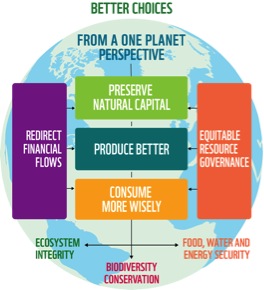October 7, 2014 —  We are all connected. Farmer or finance minister, president or plumber, we share the same home — this single, living planet. It’s the only home we have. And from my perspective it’s in dire need of attention.
We are all connected. Farmer or finance minister, president or plumber, we share the same home — this single, living planet. It’s the only home we have. And from my perspective it’s in dire need of attention.
My perspective comes in part from the latest edition of the Living Planet Report — WWF’s 10th “state of the planet” account of how things are progressing on the “pale blue dot” — as Carl Sagan famously called our planet back in 1994. As editor of the Living Planet Report, I spend a lot of time trying to bring people around to my perspective — a One Planet Perspective — starting a lot of conversations by just sharing the data that shows humanity is leaving too big of a footprint on our planet.
We have a lot of powerful evidence that points to a need for change. But even if I put all that aside, it comes down to a simple question: What’s the alternative to a One Planet Perspective? Do any of us have a spare Earth stashed away somewhere? I don’t think so. So, it’s probably best that we change the way we act on this one.
With limited, and in many cases, dwindling natural capital, it is increasingly looking like we will be unable to provide all of the food, water and energy that we need for 9 or 10 (or more) billion people in the decades ahead.
Unfortunately, as in all previous editions of the report, the picture is not pretty: Biodiversity (as measured by the Living Planet Index generated by the Zoological Society of London) is continuing to decline, and humanity’s impact (as measured by the Ecological Footprint from Global Footprint Network) is continuing to increase.
Integrally connected — like two sides of the same coin — these ecological and socio-economic domains interact in a way that determines not only the health of the planet, but also the health and well-being of all of us. And, with limited, and in many cases, dwindling natural capital, it is increasingly looking like we will be unable to provide all of the food, water and energy that we need for 9 or 10 (or more) billion people in the decades ahead.
Certainly, the Living Planet Index isn’t the only measure of the health of the natural world. For some, this index and the Ecological Footprint may not provide a complete picture, and it’s good that people are asking questions and having debates. But clocks are ticking, and our planet is changing right before our eyes.
One person who’s seen our “pale blue dot” from a vantage few have shared is Dutch astronaut André Kuipers. In a unique collaboration between WWF and the European Space Agency, Kuipers launched the 2012 edition of the Living Planet Report from the International Space Station — saying:
“All of the life (on Earth) is taking place in 10 kilometers of air, and 10 kilometers of ocean. That’s it. Seemingly huge on the ground, and you cannot count the trees. But from space…”
From space you get a different perspective: a One Planet Perspective.
Just as an astronaut can see the whole Earth from space, the Living Planet Index and the Ecological Footprint are long-term time-series data sets that paint a big picture. To fill out the picture and enhance our understanding of the state of the planet at a global scale, the Living Planet Report includes other, complementary indicators, such as the Water Footprint (provided by the Water Footprint Network) and Planetary Boundaries (from the Stockholm Resilience Centre). It also looks at other global-scale data — such as atmospheric carbon dioxide levels, forest cover, fish stocks and water scarcity in the world’s major river basins.
 But it is really only by looking at indicators at smaller scales — national, regional and local, and especially ecoregion or ecosystem — that we can get the clearest picture of what is happening to our planet. If we’re prepared to look, these indicators are all around us.
But it is really only by looking at indicators at smaller scales — national, regional and local, and especially ecoregion or ecosystem — that we can get the clearest picture of what is happening to our planet. If we’re prepared to look, these indicators are all around us.
I come from one of the most fragile and threatened corners of the planet — the Southwest Australia Ecoregion — where I grew up on a farm and watched, year by year, healthy woodlands being cleared and degraded and productive agricultural land being lost. Rainfall declined — by about 15 percent since the 1970s — and, more alarmingly, stream flow (the rainfall runoff that flowed into our water reservoirs) dropped by 40 percent. Recent research has predicted that, as a result of climate change, rainfall will continue to decline there — a further 40 percent by the end of this century.
Looking “in my own backyard,” I witnessed firsthand changing climatic conditions, decreasing rainfall, depleting groundwater, increasing water scarcity and increasing salinization. I watched as land was degraded, soil eroded and soil fertility lost, and even species rendered locally extinct. This is the information that we need to heed. It all adds up to that global picture, and provides a workable scale for many of us to make a difference. From “their own backyard,” others have witnessed and recorded shrinking fisheries, retreating glaciers, infestations of invasive species, loss of water quality, decline of ecosystems — in rivers, lakes, wetlands, forests and mangroves — extinctions of species, and many other impacts.
Fortunately, these impacts are not the focus of the One Planet Perspective. Instead, the report focuses on solutions — finding ways to secure our food, water and energy in a way that is in harmony with the natural boundaries of the planet. It’s about reducing humanity’s negative, ecosystem-degrading impacts and implementing positive, ecosystem-preservation practices. It’s about protecting our natural capital, producing better, consuming more wisely, managing financial flows for the benefit of the planet, and governing resources equitably.
These solutions are all connected. These solutions are in our hands. We’re in this together, and unless you do have another Earth stashed away, there’s really no other alternative.
![]()
Download the 2014 edition of the Living Planet Report at panda.org/lpr.
Editor’s note: The views expressed here are those of the author and not necessarily of Ensia. We present them to further discussion around important topics. We encourage you to respond with a comment below, following our commenting guidelines, which can be found here. In addition, you might consider submitting a Voices piece of your own. See Ensia’s “Contact” page for submission guidelines.
Ensia shares solutions-focused stories free of charge through our online magazine and partner media. That means audiences around the world have ready access to stories that can — and do — help them shape a better future. If you value our work, please show your support today.
Yes, I'll support Ensia!
